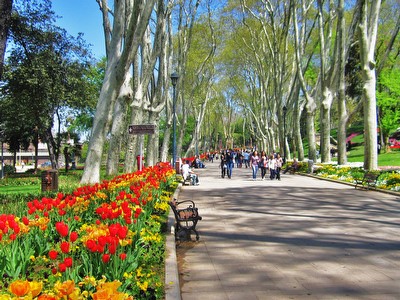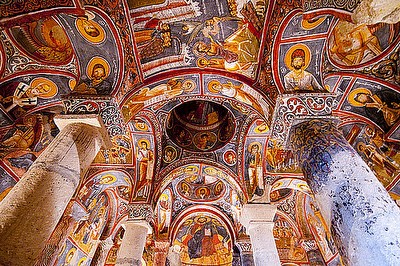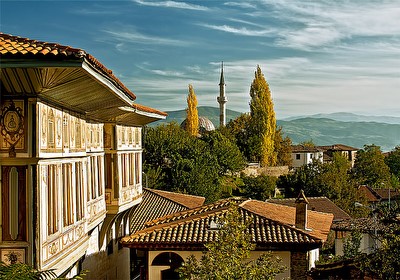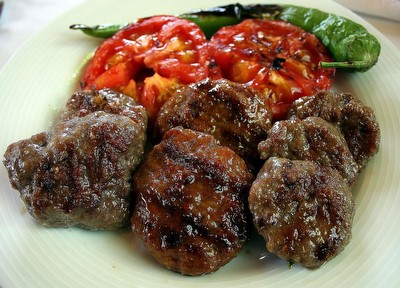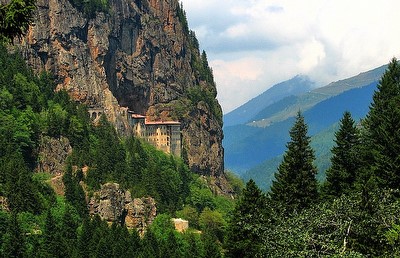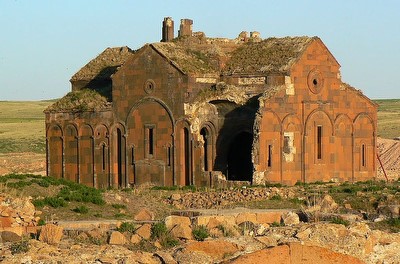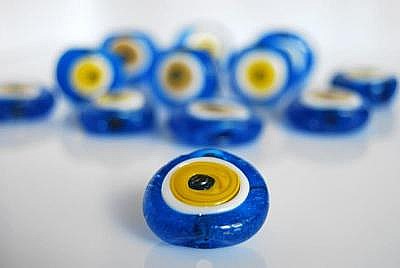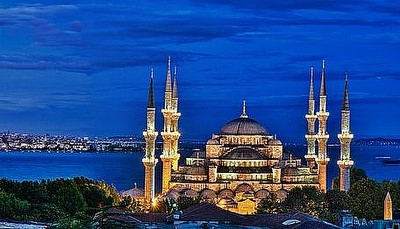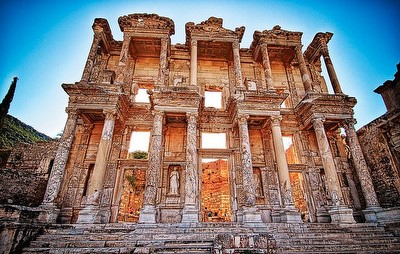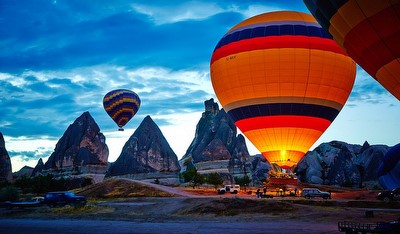TOP 10 REASONS TO VISIT TURKEY
1. ARCHITECTURE
2. CUISINE
3. CARPETS
4. ACTIVITY SPORTS
5. FLORA AND FAUNA
6. RELIGION
7. HOT AIR BALLOONING
8. TURKISH RIVIERA
9. GÖBEKLITEPE
10. CALLIGRAPHY & EBRU
1. Architecture.
For over 3,000 years Türkiye has witnessed numerous architectural styles of different civilisations.
The country has more ruined Roman and Greek cities than there are in Italy and Greece, combined. The excavations and restoration of the once mighty city of Ephesus has revealed magnificent buildings, such as the Library of Celsus, which now stand as they did 2,000 years ago. Throughout Anatolia there are impressive and magnificent amphitheatres.
The Greeks used the theaters for sophisticated performances of plays and music, whilst their less refined Roman successors used the them as a venue for bloody gladiatorial fights.
2. Cuisine.
Turkish Cuisine uses only the finest and freshest ingredients. Whether its a Five Star Hotel Restaurant or a small village "Lokanta" you are guaranteed food that will make the taste buds tingle. Breakfasts begin with fresh Aegean Olives, Tomatoes and Cucumbers picked straight from the vine and locally made goats cheese accompanied by a green salad tossed in virgin olive oil. Lunches and Dinners begin with an array of Mezes, appitizers followed by Succulent lamb Kebabs, juicy chicken legs or prime beef steaks, all seasoned with oriental spices and grilled to perfection. Freshly caught Sea Food of the highest quality is to be found all along the Aegean and Mediterannean coasts. To confirm the Turkish "Sweet Tooth" the assortment of desserts is amazing from rice pudding to the world famous Baklava. To wash this veritable banquet down, each meal can be accompanied by fine Cappadocian Wines and rounded off with thick, sweet Turkish style Coffee.
3. Carpets.
Ask anyone where can you find the best carpets in the world and the reply will, more than likely, be Persia.However carpet weaving was introduced into Anatolia by the Türkoman nomads from Central Asia.The striking designs and bright colours of Anatolian carpets have been compared with those from Central Asia and, in particular, Persia.Geometric patterns are most predominant and the inclusion of symbols such as The Tree of Life, which symbolises the axis of the world, and the scorpion, to ward off evil, were often incorporated into the design. Many also bore religious symbols such as the Cross, the Swastika and the Six Pointed Star. Motifs often expressed the emotional feelings of the carpet weaver and also reflected pre-Islamic beliefs of a particular clan or tribe.
4. Activity Sports.
With its vast mountains, plains, seas and unspoilt scenery, Türkiye has begun to realize its vast potential as major venue for adventure sports. Due to the popularity of Scuba Diving the Marmaris Belediye, sunk a derelict ship to enable divers to experience "wreck" diving. In the waters around the Bodrum peninsular there are ships and a C30 cargo plane which can be explored whilst he west coast of the Gallipoli Peninsula offers the opportunity to swim amongst the WW I ships that remain on the sea bed. Rock climbing is beginning to become more popular with the Aladağlar and the Beydağlari offering single and multi-pitch routes over the limestone peaks. Horse riding centers cater for would be cowboys, with both solo and group rides into the forests and mountains. The three week or so walk along the "Lycian Way" is a challenge for even the most experienced hiker. The mild winter climate of Antalya means that its five Championship Golf Courses are open all year round. One of the most foremost rafting rivers in the world is the Coruh River, in the northeast. Riding the rapids, which in early summer can reach a heart stopping grade five, is only for the experienced rafter. Ideal conditions for sea kayaking can be found in the Kekova area. Erzurum, offers the experienced skiers long and challenging pistes. With its modern hotels, ski lifts, fitness centers, up market shops and boutiques and a lively "apre-piste" scene, the town could easily be mistaken for a Tyrolean resort.
5. Flora and Fauna.
With an actual land mass exceeding 800,000Km2 Turkey is home to a huge variety of Flora and Fauna In the Pontiac region the deciduous forests are of particular beauty in the autumn when the mountains are ablaze with the splashes of changing colours. High above the alpine meadows there are an abundance of Azaleas and Rhododendrons. In the Aegean and Med regions pine trees are the norm and bee keepers take advantage of the trees to produce "Pine Honey" which has a distinct but pleasant flavour. In the Beşkonak region the rare Wild Mediterranean Cypress grow. On the slopes of the Taurus mountains the ancient Cedar of Lebanon, Cedrus libani, and Junipers can be found. Amongst the trees is the "Maquis", a prickly assortment of bushes and plants, which include Holly Oak and wild herbs such as Thyme and Sage. In the spring the meadows, orchards and scrub are ablaze with poppies, scabious, daisies, anemones, iris and many other wild flowers and bulbs such as crocus, snowdrops, wild hyacinths and cyclamen.The Dilek Milliparki. With its flat marshland and 1,128m high mountains it is home to many birds of prey, and scavengers such as the "Kara Akbaba", "Black Vulture", wild boar, stripped hyenas, jackals and the extremely rare mountain leopard. In the spring the flowering rock roses and lavender attract vast numbers of butterflies.The forests are home to boar, red and roe deer, wolves and the odd bear or two.In the Kakar Mountains in the Taurus, Ibex, chamois, wolves and wild cats still roam in the more remote regions and foxes, badgers and porcupines can often be seen, usually after dusk.
6. Religion.
Despite many conservative strongholds, most Turks are very relaxed in their attitude to religion, but no matter where one travels within the country, the outward signs, mosques and minarets, are clearly visible and the calling of the faithful to prayer audible. Several references are made in the Old Testament of the Holy Bible, such as Noah´s Ark, which it is said came to rest on Mount Ararat, and in the town of Harran, where Abraham lived with his family.
In Hatay, ancient Antioch, the term "Christian" was first used in 40AD to describe the followers of Christ and the city became the centre from which the new religion spread across the Anatolian plains. Paul, along with Barnabas, set out from Antioch on the first of three of his missionary journeys. Over the following decade he travelled through the towns and cities across western Anatolia. Paul visited Alexandria Troias, Antalya, Assos, Attalia, Iconium, Konya, Miletus, Myra and Patara and also lived in the city of Ephesus.In the last book of the Holy Bible, Revelation 1:11, the Seven Churches of Asia, Ephesus, Laodicea, Pergamum, Philadelphia, Sardis, Sarta, Smyrna and Thyatira are mentioned.
7. Ballooning.
Just before the break of dawn the huge wicker basket with its 16 - 24 passengers rises slowly into the clear blue skies above the lunar landscape of Cappadocia. These colourful giants give a whole new perspective to the rugged terrain below as they float silently through the air. After each flight you are welcomed back onto Mother Earth with a glass of Turkish "Champagne"
8. Turkish Riviera.
The crystal clear turquoise waters along the Mediterranean Sea are known as the Turkish Riviera and its many ports and resorts are popular with sun seekers and yachtsmen from across the globe. From cosmopolitan marinas to quaint villages sheltered in secluded harbours, the coastline is ideal for those wishing to soak up the sun and history of this fascinating region. When sailing through the waters, yachts and boats are frequently "escorted" by pods of dolphins and between May and October Loggerhead Turtles can be seen heading for the breeding grounds.
9. Göbeklitepe.
The Neolithic hilltop sanctuary of Göbeklitepe is the oldest known human-made religious structure, which was first discovered in an archaeological field survey undertaken by the Universities of İstanbul and Chicago in 1964. It is situated at the top of a mountain ridge in southeastern Anatolia, some 15 kilometres northeast of the town of Şanliurfa and contains 20 round structures which had been buried, four of which have been excavated. Each round structure has a diameter of between 10 and 30m, 33 and 98 ft, and all are decorated with massive, mostly T-shaped, limestone pillars that are the most striking feature of the site. The limestone slabs were quarried from bedrock pits located around 100m, 330 ft, from the hilltop, with neolithic workers using flint points to carve the bedrock. The majority of flint tools found at the site are Byblos and Nemrik points. That Neolithic people, with such primitive flint tools quarried, carved, transported uphill, and erected these massive pillars has astonished the archaeological world, and must have required a staggering amount of manpower and labour.
10. Calligraphy & Ebru.
Calligraphy was probably the most important Ottoman art form. The ornate and highly stylized form of handwriting was used to decorate the text of the Holy Qur'an and book covers. It was also used by the Ottoman court for edicts, deeds and correspondence. The introduction of the Latin script saw the demise of the art and today it is only practiced by a few experts. Paper marbling, known as "Ebru", was developed during the 15thC. The unique patterns are created by sprinkling dye onto a surface of water, contained in a shallow tray. The oil based paint, being of a lesser density, floats on the water.The ink is gently positioned on the surface of the water and then "moved," using a tapered stick, to produce the desired effect.A sheet of paper on top is laid on top and the unique image is transferred onto the paper. Pictures of objects, in particular, flowers, are made using this method and they are used to decorate the inside covers of books and mounted as wall pictures.


